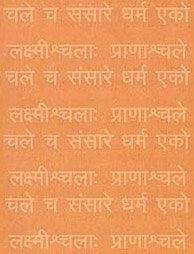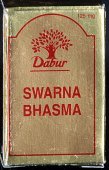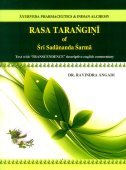Tarangini, Taraṅgiṇī, Taramgini: 10 definitions
Introduction:
Tarangini means something in Hinduism, Sanskrit, Jainism, Prakrit. If you want to know the exact meaning, history, etymology or English translation of this term then check out the descriptions on this page. Add your comment or reference to a book if you want to contribute to this summary article.
In Hinduism
Purana and Itihasa (epic history)
Source: Cologne Digital Sanskrit Dictionaries: The Purana IndexTaraṅgiṇī (तरङ्गिणी).—A river flows through the Uttarakuru country and falls into the north ocean.*
- * Vāyu-purāṇa 42. 76-7.

The Purana (पुराण, purāṇas) refers to Sanskrit literature preserving ancient India’s vast cultural history, including historical legends, religious ceremonies, various arts and sciences. The eighteen mahapuranas total over 400,000 shlokas (metrical couplets) and date to at least several centuries BCE.
Kavya (poetry)
Source: Wisdom Library: KathāsaritsāgaraTaraṅgiṇī (तरङ्गिणी) is the name of a river (nadī) situated on the other side of the eastern ocean (pūrvāmbudhi), according to the Kathāsaritsāgara, chapter 72. Accordingly, as the robber Siṃhavikrama reflected: “... and at present the hermit Śveta is on the other side of the eastern ocean, in a grove of ascetics beyond the River Taraṅgiṇī. That grove cannot be invaded by Death, so I will take you and place you there”.
The Kathāsaritsāgara (‘ocean of streams of story’), mentioning Taraṅgiṇī, is a famous Sanskrit epic story revolving around prince Naravāhanadatta and his quest to become the emperor of the vidyādharas (celestial beings). The work is said to have been an adaptation of Guṇāḍhya’s Bṛhatkathā consisting of 100,000 verses, which in turn is part of a larger work containing 700,000 verses.

Kavya (काव्य, kavya) refers to Sanskrit poetry, a popular ancient Indian tradition of literature. There have been many Sanskrit poets over the ages, hailing from ancient India and beyond. This topic includes mahakavya, or ‘epic poetry’ and natya, or ‘dramatic poetry’.
Nyaya (school of philosophy)
Source: Shodhganga: A study of Nyāya-vaiśeṣika categoriesTaraṅgiṇī (तरङ्गिणी), written by Rāmarudra Bhaṭṭācārya, is a commentary on the Bhāṣāpariccheda by Viśvanātha Nyāyapañcānana. The Bhāṣāpariccheda belongs to the syncretic school of Nyāya-Vaiśeṣika. It is known as Kārikāvalī also, on which the author himself has written a commentary called Nyāyasiddhāntamuktāvalī. This work of Viśvanātha has been commented upon by many traditional and modern scholars [viz., the Taraṅgiṇī].

Nyaya (न्याय, nyaya) refers to a school of Hindu philosophy (astika), drawing its subject-matter from the Upanishads. The Nyaya philosophy is known for its theories on logic, methodology and epistemology, however, it is closely related with Vaisheshika in terms of metaphysics.
Shaktism (Shakta philosophy)
Source: Google Books: Manthanabhairavatantram1) Taraṅginī (तरङ्गिनी) refers to the Goddess Kuṇḍalinī, according to the Manthānabhairavatantra, a vast sprawling work that belongs to a corpus of Tantric texts concerned with the worship of the goddess Kubjikā.—Accordingly, “Intent on (the practice of) the deposition (of mantra) (nyāsa), meditation, and the repetition (of mantra), he is successful by virtue of (his) association (yoga) with the Krama. By the practice of the offering of bali to the sacred seats, (the goddess) Kuṇḍalinī (Taraṅginī) is full (and satisfied). One should worship (in this way) if one wishes the most excellent accomplishment. Already knowing the purification of the mantras, one should then begin to practice Yoga”.
2) Taraṅgiṇī (तरङ्गिणी) refers to the Gesture associated with Candra, one of the eight Sacred Seats (pīṭha), according to the Yogakhaṇḍa (chapter 14) of the Manthānabhairavatantra.

Shakta (शाक्त, śākta) or Shaktism (śāktism) represents a tradition of Hinduism where the Goddess (Devi) is revered and worshipped. Shakta literature includes a range of scriptures, including various Agamas and Tantras, although its roots may be traced back to the Vedas.
Languages of India and abroad
Sanskrit dictionary
Source: Cologne Digital Sanskrit Dictionaries: Shabda-Sagara Sanskrit-English DictionaryTaraṅgiṇī (तरङ्गिणी).—f. (ṇī) A river. E. taraṅga a wave, ini and ṅīṣ affs.
Source: Cologne Digital Sanskrit Dictionaries: Aufrecht Catalogus Catalogorum1) Taraṅgiṇī (तरङ्गिणी) as mentioned in Aufrecht’s Catalogus Catalogorum:—See Kṣīrataraṅgiṇī, Tarkataraṅgiṇī, Durgābhaktitaraṅgiṇī, Rājataraṅgiṇī.
2) Taraṅgiṇī (तरङ्गिणी):—Quoted in Nirṇayasindhu and Dvaitapariśiṣṭa, probably instead of Durgābhaktitaraṅgiṇī.
3) Taraṅgiṇī (तरङ्गिणी):—vedānta, by Rāmācārya. Oppert. Ii, 896. 8735. 9035.
4) Taraṅgiṇī (तरङ्गिणी):—[tantric] Quoted in Śaktiratnākara Oxf. 101^b.
5) Taraṅgiṇī (तरङ्गिणी):—Tarkasaṃgrahaṭīkā by Vindhyeśvarīprasāda. NW. 378.
6) Taraṅgiṇī (तरङ्गिणी):—Dinakarabhaṭṭīyaṭīkā [nyāya] Oppert. 8057.
7) Taraṅgiṇī (तरङ्गिणी):—Nyāyāmṛtaṭīkā by Rāmācārya. Burnell. 108^a.
8) Taraṅgiṇī (तरङ्गिणी):—[nyāya] by Rāmarudra Bhaṭṭa. Oppert. Ii, 1253 7570.
9) Taraṅgiṇī (तरङ्गिणी):—by Rāmācārya. read 9034.
10) Taraṅgiṇī (तरङ्गिणी):—Dinakarabhaṭṭīyaṭīkā. read 8007.
11) Taraṅgiṇī (तरङ्गिणी):—by Rāmarudra. add Oppert. I, 4694. 4860.
12) Taraṅgiṇī (तरङ्गिणी):—by Rāmarudra Bhaṭṭa. See Bhāṣāparichedaṭīkā.
Source: Cologne Digital Sanskrit Dictionaries: Yates Sanskrit-English DictionaryTaraṅgiṇī (तरङ्गिणी):—(ṇī) 3. f. A river.
Source: DDSA: Paia-sadda-mahannavo; a comprehensive Prakrit Hindi dictionary (S)Taraṅgiṇī (तरङ्गिणी) in the Sanskrit language is related to the Prakrit word: Taraṃgiṇī.
Sanskrit, also spelled संस्कृतम् (saṃskṛtam), is an ancient language of India commonly seen as the grandmother of the Indo-European language family (even English!). Closely allied with Prakrit and Pali, Sanskrit is more exhaustive in both grammar and terms and has the most extensive collection of literature in the world, greatly surpassing its sister-languages Greek and Latin.
Prakrit-English dictionary
Source: DDSA: Paia-sadda-mahannavo; a comprehensive Prakrit Hindi dictionaryTaraṃgiṇī (तरंगिणी) in the Prakrit language is related to the Sanskrit word: Taraṅgiṇī.
Prakrit is an ancient language closely associated with both Pali and Sanskrit. Jain literature is often composed in this language or sub-dialects, such as the Agamas and their commentaries which are written in Ardhamagadhi and Maharashtri Prakrit. The earliest extant texts can be dated to as early as the 4th century BCE although core portions might be older.
Kannada-English dictionary
Source: Alar: Kannada-English corpusTaraṃgiṇi (ತರಂಗಿಣಿ):—
1) [noun] that which has waves on its surface; a river.
2) [noun] (mus.) a mode derived from the main mode Harikāmbhōji, in Karnāṭaka system.
Kannada is a Dravidian language (as opposed to the Indo-European language family) mainly spoken in the southwestern region of India.
See also (Relevant definitions)
Starts with: Tarangininaha, Tarangininatha.
Ends with (+49): Adbhutatarangini, Adhyatmasudhatarangini, Advaitatarangini, Amritatarangini, Anandatarangini, Bhagadbhaktitarangini, Bhaktamodatarangini, Bhaktitarangini, Bhavatarangini, Brihattarkatarangini, Dhatutarangini, Durgabhaktitarangini, Gamgataramgini, Gangabhaktitarangini, Gurutarangini, Haribhaktitarangini, Jainatarangini, Jnananandatarangini, Kavyamritatarangini, Khetatarangini.
Full-text (+73): Amritatarangini, Suratarangini, Tarkamrita, Nyayamrita, Kalhana, Taramginibhartri, Taramgininatha, Paretaramgini, Rajataramginisamgraha, Rajatarangini, Sahityataramgini, Shabdataramgini, Bhavataramgini, Vadataramgini, Yogataramgini, Yogamritataramgini, Tantragandharva, Dashamsha, Pancopacaraka, Vanataramgini.
Relevant text
Search found 21 books and stories containing Tarangini, Taramgini, Taraṃgiṇī, Taraṃgiṇi, Taraṅgiṇī, Taraṅgiṇi; (plurals include: Taranginis, Taramginis, Taraṃgiṇīs, Taraṃgiṇis, Taraṅgiṇīs, Taraṅgiṇis). You can also click to the full overview containing English textual excerpts. Below are direct links for the most relevant articles:
Sahitya-kaumudi by Baladeva Vidyabhushana (by Gaurapada Dāsa)
Text 10.78 < [Chapter 10 - Ornaments of Meaning]
Rasa Jala Nidhi, vol 5: Treatment of various afflictions (by Bhudeb Mookerjee)
Part 17 - Chemists of the Metallic School: Nagarjuna < [A Brief History of Indian Chemistry and Medicine]
Part 22 - Chemists of the Metallic School: Vagbhata, the junior < [A Brief History of Indian Chemistry and Medicine]
Part 14 - Chemists of the Metallic School: Shambhu < [A Brief History of Indian Chemistry and Medicine]
Gati in Theory and Practice (by Dr. Sujatha Mohan)
Nṛtya Nāṭaka < [Chapter 4 - Practice of Gati]
Nāṭyaśāstra and regional deśi art forms < [Chapter 4 - Practice of Gati]
Shat-cakra-nirupana (the six bodily centres) (by Arthur Avalon)
Buddhist records of the Western world (Xuanzang) (by Samuel Beal)
Chapter 4 - Country of Pun-na-fa-t’an-na (Pundravardhana) < [Book X - Seventeen Countries]
Related products
(+1 more products available)





